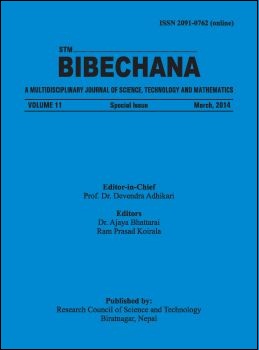Hydrogen storage on platinum decorated graphene: A first-principles study
DOI:
https://doi.org/10.3126/bibechana.v11i0.10389Keywords:
Hydrogen adsorption, DFT, Geometrical stability, Hydrogen storage, Charge transferAbstract
Adsorption of gaseous/molecular hydrogen on platinum (Pt) decorated and pristine graphene have been studied systematically by using density functional theory (DFT) level of calculations implemented by Quantum ESPRESSO codes. The Perdew-Burke-Ernzerhof (PBE) type generalized gradient approximation (GGA) exchange-correlation functional and London dispersion forces have been incorporated in the DFT-D2 level of algorithm for short and long range electron-electron interactions, respectively. With reference to the binding energy of Pt on different symmetry sites of graphene supercells, the bridge (B) site has been predicted as the best adsorption site. In case of 3×3 supercell of graphene (used for detail calculations), the binding energy has been estimated as 2.02 eV. The band structure and density of states calculations of Pt adatom graphene predict changes in electronic/magnetic properties caused by the atom (Pt). The adatom (Pt) also enhances the binding energy per hydrogen molecule in Pt-graphene comparing to that in pristine graphene and records the values within the range of 1.84 eV to 0.13 eV for one to eight molecules, respectively.
DOI: http://dx.doi.org/10.3126/bibechana.v11i0.10389
BIBECHANA 11(1) (2014) 113-122
Downloads
Downloads
Published
How to Cite
Issue
Section
License
This license enables reusers to distribute, remix, adapt, and build upon the material in any medium or format for noncommercial purposes only, and only so long as attribution is given to the creator.




